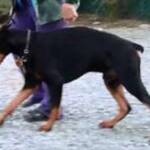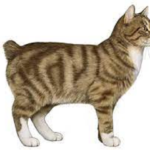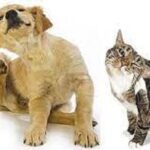The cauda equina is made up of the tail end of the spinal cord and the adjacent nerve roots. Sometimes the spinal canal, through which the spinal cord and nerves pass, narrows and compresses the nerves. The most common spot for this narrowing to occur is at the lumbosacral joint, where the spine meets the pelvis. Spinal canal narrowing at the lumbosacral joint is referred to as lumbosacral stenosis, and the condition resulting from the compression of these spinal nerve roots is called cauda equina syndrome.
The narrowing is most often caused by arthritic degeneration or intervertebral disc herniation, but traumatic injury, congenital malformation (born with it), or tumor growth can also be involved.
The most common symptom of lumbosacral stenosis is pain. In the beginning you may also notice stiffness leading to difficulty in walking, climbing stairs, getting on furniture, wagging the tail, positioning to defecate, or getting into a car. One or both back legs may become weak. Some dogs will cry out in pain when trying to move. In severe cases, the nerve roots can become so compressed that urinary and fecal incontinence will result.
German shepherd dogs and other large breeds are most commonly affected. It is unusual to see signs in dogs younger than 3 to 7 years of age.
The first diagnostic test is a physical and neurologic examination. A veterinarian observes the dog’s walk and then tries to determine where the pain is located. Additional diagnostic tests are usually required to establish the diagnosis. These include x-rays, CAT scans, MRI, and electromyography. Traditionally, a myelogram, a specialized x-ray where contrast liquid is injected into the spinal canal to outline the narrowed areas, has been the preferred test. More recently, advanced imaging techniques – especially MRI – have become the test of choice.
Treating lumbosacral stenosis depends on the cause and severity of the symptoms. Mild cases often need only supportive treatment, which includes crate rest and anti-inflammatory and pain-relieving medications. If symptoms persist or worsen, or if neurologic signs develop, a surgical procedure may be indicated. A dorsal laminectomy creates an opening in the top of the spinal canal to relieve pressure from the nerves. Occasionally, adjacent unstable spinal vertebrae may have to be fused to prevent recurrent nerve trauma. These methods can be used in the same surgery. Strict rest in the post-operative period is essential to minimize complications.
Recently, preliminary research studies have indicated that the anti-inflammatory effects produced by injecting cortisone drugs into the lumbosacral spinal canal may be as effective as surgery in some dogs. These injections are touted for the majority of cases, in which signs are mostly pain and stiffness.
The treatment approach is to start with medical treatment and leave surgery as a last resort if there is no improvement or if neurologic signs are developing. That’s more the case currently than ever before now that corticosteroid injection is an option.
Dogs with mild signs have a good prognosis as they can be medically treated. Severely affected dogs, including those whose nerve root compression is so severe that urinary or fecal incontinence has resulted, have a poor prognosis as most such dogs do not become continent again, even after surgery. However, surgery or epidural cortisone can relieve pain and improve quality of life.


